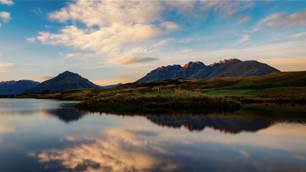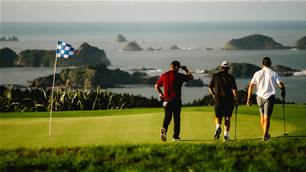New Zealand’s largest city, Auckland, is many things.
“We’ve always struggled when people ask, ‘What’s the signature hole?’ To us, that means one is so much better than the others,” Coore said. “That question also requires that I be 100 percent objective, and I can’t do that either. Not at Te Arai Links.
“This is going to sound like diplomatic jargon, but in my own mind – being as critical and objective as I can be – there aren’t two-three ‘wow’ holes at Te Arai Links that are so much better than the others. There just aren’t.
“However, there are, without a doubt, a great many gorgeous golf holes out there: 4-5-6, 7-8-9, 11, 13, 15-16-17…
“People will surely talk about all the par-3s, and they’ll take amazing pictures there, too. I just hope they notice those par-3s are all oriented in such a way that golfers always see the ocean – even though they all play in different directions. And one of the most interesting short holes is 12, which plays away from the ocean.

“I think Willie Nelson once said, ‘all you can do is create something you feel is good, throw it out there, and someone will tell you if it’s good or not’.”
Like most Coore and Crenshaw designs, the South Course is a product of its unique environment. Yet that assessment goes beyond matters of terrain: Coore admits it’s impossible to ignore the presence of so highly regarded a course as Tara Iti just up the beach – to say nothing of the adjoining North Course coming online later this year.
Equally difficult to ignore: the fact that Tom Doak designed each of them.
“I think there’s a huge appeal in having Doak next door, for me personally and I think Ben would agree,” Coore said. “We had that opportunity at Streamsong, Barnbougle and Bandon, of course. So, this has happened before.
“In each instance, it’s been a huge honour. Of course, there is a little good-natured competitiveness, too. You don’t want to build a course that’s not up to par with others in the complex.”
Of course, it was Tara Iti that first drew the golfing world’s focus onto this incredible stretch of the North Island’s east coastline when it opened for play in 2015. Once the coastal site was cleared of non-native pines and wattle, Doak devised his routing among the exposed sand dunes, while the sandy site was revegetated with fescue and native plants like spinifex. It wasn’t until after construction started and images started appearing on social media that Tara Iti began waltzing its way onto golfer’s bucket lists across the globe.
The hype and the fanfare have since been validated by major golf publications ranking Tara Iti in the top-30 courses in the world. And if you have hopes of playing this wonderful course, be aware that it is a very private member’s course but there are limited one-off visitor tee times, which must be organised well in advance.
It’s not so hard to get a game at Mangawhai Golf Club, an easy 15-minute drive from Tara Iti and north across Mangawhai Harbour. That said, you simply must have a hit here if you’re in the area.

Established in 1979, Mangawhai stretches to only 5,466 metres from the back pegs, which, sight unseen, would suggest a relatively short and easy 18-hole excursion. Not so. In fact. Mangawhai punches well above its weight and was once regarded one of the hardest courses in New Zealand.
It is best described as an inland links with fast-running fairways and large, firm and quick rolling greens. It is these elements that make it difficult to maintain control over your ball and give the Mangawhai layout its bite, despite it being a short journey.
Its sternest test is early in the round at the sharp dogleg right par-4 2nd. A swamp lies beyond the tree line left of the 387-metre hole, while there is also plenty of tree trouble to be found right of the fairway, which curves around sand hills. A strong drive just around the corner of the dogleg will leave a mid-iron approach to the large sloping green featuring a false front. If you can avoid a big number on this tough test, so early in the round, you’re in for a good day.
The par-3s here are also a treat with the diminutive drop-shot 13th hole, of just 135 metres from the tips, being a standout for mine. The two-tiered green has plenty of slopes to consider and while you may think the bunker at the back of the green is not in play it is. This is a little hole with a big links heart and was great fun to play.
The 175km scenic trek north via State Highway 1 from Mangawhai to the heart of the Bay of Islands region is beautiful. There are plenty of natural attractions to stopand enjoy along the way including the picturesque Whangarei Falls or the Waiomio glow worm caves.
With all due respect to these attractions, there is only one thing a golfer wants to see whilst in this area of the North Island and that’s the world-renowned Kauri Cliffs.
When Kauri Cliffs opened for play in 2000 it immediately elbowed its way onto the list of the world’s top-100 courses. It’s not hard to see why.
The late American hedge fund guru Julian Robertson bought the 4,000-acre sheep and cattle farm overlooking the Cavalli Islands with a dream to develop a world class course and guest accommodation. He succeeded, perhaps even beyond his own expectations, and further inspired him to also develop Kauri Cliffs’ sister course, Cape Kidnappers.
More than 800 of the 4,000 acres of the property are devoted to the layout, which was designed by American David Harmon, who had previously worked on projects with the Jack Nicklaus and Arnold Palmer course design companies.

When I last visited Kauri Cliffs I was the first player out on the course and more were not expected for several hours. It is not often you have such a stunning golf course all to yourself, where often the only sound you hear between shots is the whistling wind.
The unhurried nature of a round at Kauri Cliffs gives you time to soak in the spectacular holes Harmon created as well as the postcard views of the Cavalli Islands.
There are so many good holes at Kauri Cliffs it is hard to single out a few but the long par-3s – the 7th and 14th holes – really impressed. Each hole clings to the cliff tops and, despite being of similar length, they run in opposite directions, while the 7th – which was redesigned by Rees Jones in 2014 – is slightly uphill and the 14th is downhill. In fact, the 14th starts an incredible run of spectacular holes back to the colonial-style clubhouse.
Kauri Cliffs isn’t the only stunning oceanside golf resort in the far north of the island.
Related Articles

Take your golf game to the edge of the world in New Zealand

Touring New Zealand: The complete golfing package













